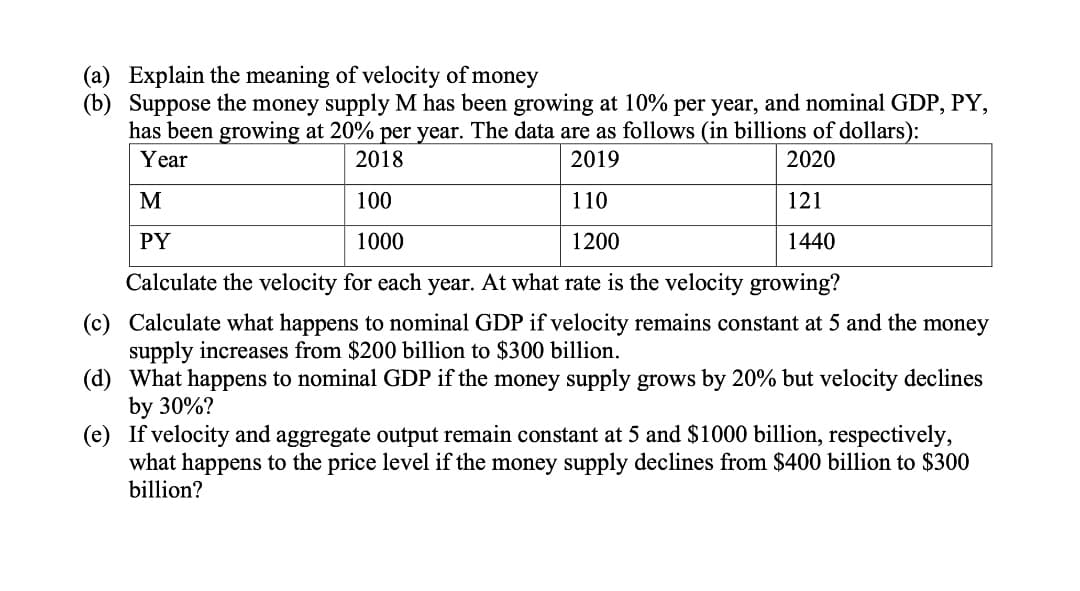(a) Explain the meaning of velocity of money (b) Suppose the money supply M has been growing at 10% per year, and nominal GDP, PY, has been growing at 20% per year. The data are as follows (in billions of dollars): Year 2018 2019 2020 M 100 110 121 PY 1000 1200 1440 Calculate the velocity for each year. At what rate is the velocity growing? (c) Calculate what happens to nominal GDP if velocity remains constant at 5 and the money supply increases from $200 billion to $300 billion.
(a) Explain the meaning of velocity of money (b) Suppose the money supply M has been growing at 10% per year, and nominal GDP, PY, has been growing at 20% per year. The data are as follows (in billions of dollars): Year 2018 2019 2020 M 100 110 121 PY 1000 1200 1440 Calculate the velocity for each year. At what rate is the velocity growing? (c) Calculate what happens to nominal GDP if velocity remains constant at 5 and the money supply increases from $200 billion to $300 billion.
Chapter15: Monetary Theory And Policy
Section: Chapter Questions
Problem 3.6P
Related questions
Question
6

Transcribed Image Text:(a) Explain the meaning of velocity of money
(b) Suppose the money supply M has been growing at 10% per year, and nominal GDP, PY,
has been growing at 20% per year. The data are as follows (in billions of dollars):
Year
2018
2019
2020
M
100
110
121
PY
1000
1200
1440
Calculate the velocity for each year. At what rate is the velocity growing?
(c) Calculate what happens to nominal GDP if velocity remains constant at 5 and the money
supply increases from $200 billion to $300 billion.
(d) What happens to nominal GDP if the money supply grows by 20% but velocity declines
by 30%?
(e) If velocity and aggregate output remain constant at 5 and $1000 billion, respectively,
what happens to the price level if the money supply declines from $400 billion to $300
billion?
Expert Solution
This question has been solved!
Explore an expertly crafted, step-by-step solution for a thorough understanding of key concepts.
This is a popular solution!
Trending now
This is a popular solution!
Step by step
Solved in 2 steps

Knowledge Booster
Learn more about
Need a deep-dive on the concept behind this application? Look no further. Learn more about this topic, economics and related others by exploring similar questions and additional content below.Recommended textbooks for you


Essentials of Economics (MindTap Course List)
Economics
ISBN:
9781337091992
Author:
N. Gregory Mankiw
Publisher:
Cengage Learning

Brief Principles of Macroeconomics (MindTap Cours…
Economics
ISBN:
9781337091985
Author:
N. Gregory Mankiw
Publisher:
Cengage Learning


Essentials of Economics (MindTap Course List)
Economics
ISBN:
9781337091992
Author:
N. Gregory Mankiw
Publisher:
Cengage Learning

Brief Principles of Macroeconomics (MindTap Cours…
Economics
ISBN:
9781337091985
Author:
N. Gregory Mankiw
Publisher:
Cengage Learning


Macroeconomics: Principles and Policy (MindTap Co…
Economics
ISBN:
9781305280601
Author:
William J. Baumol, Alan S. Blinder
Publisher:
Cengage Learning

Principles of Economics 2e
Economics
ISBN:
9781947172364
Author:
Steven A. Greenlaw; David Shapiro
Publisher:
OpenStax